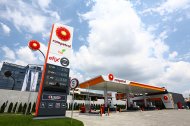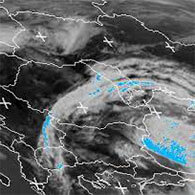THE ROMANIAN SECTOR OF ROAD HAULAGE SERVICES - SIGNIFICANTLY INCREASING REVENUES, BUT HIGHER AND HIGHER LOSSES
THE ROMANIAN SECTOR OF ROAD HAULAGE SERVICES - SIGNIFICANTLY INCREASING REVENUES, BUT HIGHER AND HIGHER LOSSES
11 Jun, 2014 12:13
ZIUA de Constanta
 1185
Marime text
1185
Marime text
 1185
Marime text
1185
Marime text
Last period was a very good one under the auspices of sales growth for the companies within the road haulage services sector, but this is not visible in their financial performances and overall the sector registered a net loss. This is due to a very aggressive competitive environment, a monopolistic marketplace that brings together companies with a high level of financial and operational leverage. Recent years have marked a period of increased investments, but funded in a defective way by a very low degree of capitalization.
According to the financial statements published by the Ministry of Finance, the companies whose main activity was the "road haulage of goods" during 2012 generated a total turnover of 24 BRON and 130,233 jobs, owning a share of 3.5% of the registered number of employees within the entire economy.
Although lately we noticed a positive evolution of the turnover in the sector, the negative dynamics of the net result requires an analysis of multiple factors to identify the triggers behind this situation.
Thus, if considering the distribution of these companies by turnover, it can be concluded that:
§ Almost 25% of the companies that have filed their statements for 2012 have not really developed any activity;
§ Half of the active companies registered a turnover of less than 100 KEUR/ year, but the share of the value in the total turnover of this segment is only 8%;
§ Only 904 companies in this sector registered an annual turnover of more than 1 MEUR, representing 3% of the total active companies, but generated about 63% of the revenues registered within the entire sector.
Following the structure of the profit & loss account for the companies in the sector and its impact on the balances registered in the consolidated balances, there can be distinguished the following conclusions:
§ 2012 was a favorable year in terms of commercial evolution; only 3 of 10 active companies registered a contraction of their turnover. The rest, registered revenue growth and 43% of them had turnover increases of over 25%;
§ The net result has evolved much weaker, both in terms of absolute values and its dynamics; half of the companies registered a net loss at the end of 2012.
The significant difference between the positive development of the turnover and the negative dynamics of the net result indicates a top-down load within the profit & loss account with an increase of the operational and financial expenses. Consequently, the share of depreciation and financial costs increased compared to turnover.
Taking into consideration the resources in terms of attracting funding and the allocation of resources for long-term investments, we can say that:
§ In the last period, the analyzed companies have allocated significant resources for investments to increase the number of fixed assets; 2 of the 10 companies doubling its asset value;
§ Companies in the road haulage sector were marked by a slightly negative working capital, given that long-term funds were not sufficient to cover long-term investments (tangible fixed assets);
§ In terms of numerical share of indebted companies, the figures indicate that 5 of the 10 companies show a negative capitalization degree (equivalent to a debt of over 100%), which are predominantly small size firms or below average.
Liquidity ratios have deteriorated over the past year, based on the increases of balances from suppliers and banks and the average increase of the DSO of short-term debts. This means that the analyzed firms have redistributed some of the funds raised on short term (running overdue invoices to suppliers, ensuring a constantly growing supplier-credit and increasing debt balances for the banks) for long-term investments, given that the level of capitalization was very low and the revenues, while growing, did not result in a net positive result.
A liquidity analysis of the companies from the road haulage sector is completed by investigating the cash-flow, which can be seen in the actual transactions of payments and receipts for all operational activities, financial or investment. In the study conducted by Coface, opted for an analysis of the correlation between the dynamics of turnover and effective liquidity ratios and we found that 70% of the firms that reported an increase in turnover, in reality they encountered liquidity issues. This confirms that the commercial development of the analyzed companies in 2011 - 2012 was not a qualitative one in terms of revenue (they exhibit volatility and a low degree of monetary persistence).
The evolution of the companies from the road haulage sector within the previous years impacts the course of 2013
The delicate financial situation of the firms in the sector, marked especially by the poor operational performance and the poor liquidity has left its mark on the evolution of companies during 2013. Specifically, 4,295 companies from road transportation goods sector have ceased their activity (with an average of 12 years of activity, a cumulative turnover of 1.25 BEUR given that the total debt exceeded 2.5 BRON).
The volume and the caliber of the companies that have ceased activity during 2013 are approximately equal to that of the established companies in the sector in both 2011 & 2012.
For 2013, Coface has analyzed individually in terms of risk class and the payment behavior, a sample of 2,752 companies in the sector (existing in its own portfolio), which generated about 61% of the total turnover registered in the entire sector.
It was found that 71% of the analyzed companies pose a risk of insolvency higher than the average and 1/3 of them registered a high risk.
Taking into consideration the payment system, almost 55% of the companies make payments very slowly, or do not respect their contracts and only 20% make payments without delay.
„Although the Government has taken concrete measures to maintain prices and regional competitiveness, in terms of road transport of goods remains to be seen what impact will it have the increase of the excise on fuel on the financial results of 2014 for the companies in the sector. Even if they recover 4 cents out of 7, their financial situation is already precarious, propagated from the past, and it could have an effect on long-term stability and profitability.” mentioned Constantin Coman, Country Manager, Coface Romania.
According to the financial statements published by the Ministry of Finance, the companies whose main activity was the "road haulage of goods" during 2012 generated a total turnover of 24 BRON and 130,233 jobs, owning a share of 3.5% of the registered number of employees within the entire economy.
Although lately we noticed a positive evolution of the turnover in the sector, the negative dynamics of the net result requires an analysis of multiple factors to identify the triggers behind this situation.
Thus, if considering the distribution of these companies by turnover, it can be concluded that:
§ Almost 25% of the companies that have filed their statements for 2012 have not really developed any activity;
§ Half of the active companies registered a turnover of less than 100 KEUR/ year, but the share of the value in the total turnover of this segment is only 8%;
§ Only 904 companies in this sector registered an annual turnover of more than 1 MEUR, representing 3% of the total active companies, but generated about 63% of the revenues registered within the entire sector.
Following the structure of the profit & loss account for the companies in the sector and its impact on the balances registered in the consolidated balances, there can be distinguished the following conclusions:
§ 2012 was a favorable year in terms of commercial evolution; only 3 of 10 active companies registered a contraction of their turnover. The rest, registered revenue growth and 43% of them had turnover increases of over 25%;
§ The net result has evolved much weaker, both in terms of absolute values and its dynamics; half of the companies registered a net loss at the end of 2012.
The significant difference between the positive development of the turnover and the negative dynamics of the net result indicates a top-down load within the profit & loss account with an increase of the operational and financial expenses. Consequently, the share of depreciation and financial costs increased compared to turnover.
Taking into consideration the resources in terms of attracting funding and the allocation of resources for long-term investments, we can say that:
§ In the last period, the analyzed companies have allocated significant resources for investments to increase the number of fixed assets; 2 of the 10 companies doubling its asset value;
§ Companies in the road haulage sector were marked by a slightly negative working capital, given that long-term funds were not sufficient to cover long-term investments (tangible fixed assets);
§ In terms of numerical share of indebted companies, the figures indicate that 5 of the 10 companies show a negative capitalization degree (equivalent to a debt of over 100%), which are predominantly small size firms or below average.
Liquidity ratios have deteriorated over the past year, based on the increases of balances from suppliers and banks and the average increase of the DSO of short-term debts. This means that the analyzed firms have redistributed some of the funds raised on short term (running overdue invoices to suppliers, ensuring a constantly growing supplier-credit and increasing debt balances for the banks) for long-term investments, given that the level of capitalization was very low and the revenues, while growing, did not result in a net positive result.
A liquidity analysis of the companies from the road haulage sector is completed by investigating the cash-flow, which can be seen in the actual transactions of payments and receipts for all operational activities, financial or investment. In the study conducted by Coface, opted for an analysis of the correlation between the dynamics of turnover and effective liquidity ratios and we found that 70% of the firms that reported an increase in turnover, in reality they encountered liquidity issues. This confirms that the commercial development of the analyzed companies in 2011 - 2012 was not a qualitative one in terms of revenue (they exhibit volatility and a low degree of monetary persistence).
The evolution of the companies from the road haulage sector within the previous years impacts the course of 2013
The delicate financial situation of the firms in the sector, marked especially by the poor operational performance and the poor liquidity has left its mark on the evolution of companies during 2013. Specifically, 4,295 companies from road transportation goods sector have ceased their activity (with an average of 12 years of activity, a cumulative turnover of 1.25 BEUR given that the total debt exceeded 2.5 BRON).
The volume and the caliber of the companies that have ceased activity during 2013 are approximately equal to that of the established companies in the sector in both 2011 & 2012.
For 2013, Coface has analyzed individually in terms of risk class and the payment behavior, a sample of 2,752 companies in the sector (existing in its own portfolio), which generated about 61% of the total turnover registered in the entire sector.
It was found that 71% of the analyzed companies pose a risk of insolvency higher than the average and 1/3 of them registered a high risk.
Taking into consideration the payment system, almost 55% of the companies make payments very slowly, or do not respect their contracts and only 20% make payments without delay.
„Although the Government has taken concrete measures to maintain prices and regional competitiveness, in terms of road transport of goods remains to be seen what impact will it have the increase of the excise on fuel on the financial results of 2014 for the companies in the sector. Even if they recover 4 cents out of 7, their financial situation is already precarious, propagated from the past, and it could have an effect on long-term stability and profitability.” mentioned Constantin Coman, Country Manager, Coface Romania.
|
About Coface The Coface Group, a worldwide leader in credit insurance, offers companies around the globe solutions to protect them against the risk of financial default of their customers, both on the domestic market and for export. In 2013, the Group, supported by its 4,440 staff, posted a consolidated turnover of €1.440 billion. Present directly or indirectly in 97 countries, it secures transactions of over 37,000 companies in more than 200 countries. Each quarter, Coface publishes its assessments of country risk for 160 countries, based on its unique knowledge of companies’ payment behavior and on the expertise of its 350 underwriters located close to customers and their debtors. In France, Coface manages export public guarantees on behalf of the French state. Coface is a subsidiary of Natixis, corporate, investment management and specialized financial services arm of Groupe BPCE. www.coface.com |
Urmareste-ne pe Grupul de Whatsapp
Comentarii
 Fondul Documentar Dobrogea de ieri și de azi
Fondul Documentar Dobrogea de ieri și de azi




















